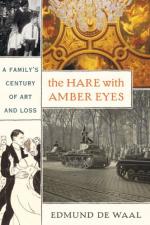|
This section contains 532 words (approx. 2 pages at 400 words per page) |

|
The Hare with Amber Eyes: A Family's Century of Art and Loss Summary & Study Guide Description
The Hare with Amber Eyes: A Family's Century of Art and Loss Summary & Study Guide includes comprehensive information and analysis to help you understand the book. This study guide contains the following sections:
This detailed literature summary also contains Topics for Discussion and a Free Quiz on The Hare with Amber Eyes: A Family's Century of Art and Loss by Edmund de Waal.
"The Hare with the Amber Eyes," is a personal story but one that is teemed with history. The author, Edmund de Waal, is a member of the large and prominent Jewish Ephrussi family. Edmund shares his story about discovering the history of his family while in search of the history of a Japanese netsuke collection that was first purchased by a family member in Paris in the late 19th century. The title of the book is a reference to his favorite piece of the collection of netsuke carvings of a hare with amber eyes.
The story of the family began in Odessa, Russia, where ancestors of Edmund launched their prosperous export business. The family patriarch was know as the King of Grain as his company had cornered the grain export market. The family eventually transferred its business expertise to the banking industry. The family wanted to expand its reach and younger members of the family were sent off to Paris and Vienna to set up banking operations that would ultimately prove a dominant force in Europe. The family became quite prosperous and accumulated great wealth and all its trappings.
Charles Ephrussi, who had settled in Paris, was unique in the Ephrussi family for his disinterest in business and his love for art. He became a celebrated art dealer and collector in fine art. During his lifetime, many of the grand French painters of the era were his contemporaries and friends. They included Renoir, Monet, Manet, and Pissaro among others. Charles became interested in Japanese art which had become the rage. He became intrigued with the intricately carved artwork known as netsuke. Charles purchased a set of the figures, 264 pieces in all, and showcased them in a large vitrine or a case with green velvet-lined shelves and glass doors for display.
When the fervor for Japanese art began to fade, Charles sent the vitrine and the netsuke to his cousin Viktor in Vienna as a wedding gift. Edmund learned that in later years, the vitrine with the netsuke were kept in Viktor's wife's dressing room where her children would play with the small figures. One of these children was Elisabeth, Edmund's grandmother. Viktor's world was turned upside down when Vienna was occupied by the Nazis in the late 1930s. A loyal maid smuggled the small pieces of the collection by hiding them in her apron pockets and thus saved the collection, one of a very few family possessions that stayed in tact through the occupation.
Later, Elisabeth passed the netsuke collection onto one of her children, Iggie, who eventually moved to Tokyo, and brought the collection back to the land of its original creation. After his passing, Edmund himself became the owner of the netsuke and as late as 2009, when this book was published, the netsuke collection was on display in Edmund's house in London in a new vitrine. He allows his children to play with them just as his grandmother did. But as history has demonstrated, it will not be the final place for the netsuke collection. But as Edmund learned, the history of this rare art will continue just as the history of the Ephrussi family continues.
Read more from the Study Guide
|
This section contains 532 words (approx. 2 pages at 400 words per page) |

|



